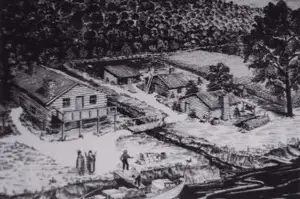The Making of the 50 States: Nebraska
Part 1: In the Beginning 
Native Americans living in what is now Nebraska included the Arapaho, Cheyenne, Dakota Siox, Kansa, Lakota Sioux, Missouria, Omaha, Otoe, Pawnee, Ponca, Sac and Fox, and Winnebago. Spanish explorer Francisco Vasquez de Coronado traveled through the area in 1541. The first European power to claim what is now Nebraska was France, when René-Robert Cavalier, Sieur de La Salle traveled down the Mississippi River and claimed all the land drained by it for his king, Louis XIV. Another Frenchman, Etienne Veniard de Bourgmont was the first Frenchman to set foot in Nebraska, in 1714. A few years later, a Spanish explorer, Pedro de Villasur, met with resistance from a group of Pawnee; Villasur and two dozen of his men were killed in the skirmish. After Great Britain defeated France in the French and Indian War, Nebraska and the rest of the land that France owned west of the Mississippi River became the property of Spain. Spanish traders Juan Munier and Jacques D'Eglise found favor with the Mandan and Ponca and established successful trade networks. 
The Treaty of San Ildefonso in 1800 gave the Louisiana Territory gave back to France, which kept it for only three years, selling it to the United States as the Louisiana Purchase in 1803. Meriwether Lewis and William Clark went through the area in 1804, on their way to the Pacific. Other famous explorers, including Zebulon Pike, followed. A pair of French-Canadian explorers, Paul and Pierre Mallet, traveled the Platte River and named it. Traders set up posts, including Fort Charles, on the Niobrara River and the Missouri River. One well-known representative of John Jacob Astor's American Fur Company, Jean-Pierre Cabanné, set up a trading post near Fort Lisa, itself a Spanish trading post set up in 1812. The St. Louis Missouri Fur Company was a force in this area as well. The U.S. Army got involved in 1820, building Fort Atkinson. An Army explorer, Stephen H. Long, went through the area in 1820 and reported that the area was not favorable for settlement. Partly as a result of this, the non-Native American population of Nebraska grew slowly. The first permanent settlement, at Bellevue, came in 1823. Next page > The Rest of the Story > Page 1, 2 |
|
Social Studies for Kids
copyright 2002–2024
David White




